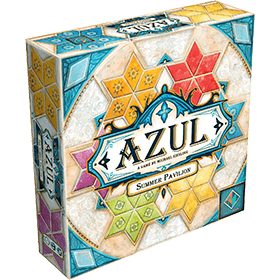Azul: Pabellón de Verano
 A principios del siglo XVI, el rey Manuel I encargó a los mejores artesanos de Portugal la construcción de grandiosos edificios. Tras terminar los Palacios de Évora y de Sintra, el rey deseaba construir un Pabellón de Verano para honrar a los miembros más célebres de la familia real. Esta tarea se encomendó a los artesanos con más talento, cuyas habilidades satisfacían el esplendor que la familia real merecía. Por desgracia, el rey Manuel I murió antes incluso de que comenzara la construcción.
A principios del siglo XVI, el rey Manuel I encargó a los mejores artesanos de Portugal la construcción de grandiosos edificios. Tras terminar los Palacios de Évora y de Sintra, el rey deseaba construir un Pabellón de Verano para honrar a los miembros más célebres de la familia real. Esta tarea se encomendó a los artesanos con más talento, cuyas habilidades satisfacían el esplendor que la familia real merecía. Por desgracia, el rey Manuel I murió antes incluso de que comenzara la construcción.
En Azul: Pabellón de Verano, los jugadores regresan a Portugal para cumplir la tarea que nunca se inició; como maestros artesanos, tendrán que utilizar los mejores materiales para crear el Pabellón de Verano, siempre con cuidado de no desperdiciar suministros. Solo los mejores podrán hacer frente al desafío de honrar a la familia real portuguesa.
Número de jugadores: 2 - 4
Duración de la partida: 25 mn
Complejidad: 2 / 5
Juega Azul: Pabellón de Verano y 974 otros juegos en línea.
No es necesaria ninguna descarga - juega directamente desde tu navegador.
Con tus amigos y con miles de jugadores del mundo entero.
Gratis.

Juega Azul: Pabellón de Verano y 974 otros juegos en línea.
No es necesaria ninguna descarga - juega directamente desde tu navegador.
Con tus amigos y con miles de jugadores del mundo entero.
Gratis.

Sumario de reglas
Overview
Have the most points after 6 rounds
Phase 1: Collection
On your turn, you either take from a Factory or take from the Middle
If you take from Factory, pick one colour which is not the Wild Colour in the Factory and take all of that colour within that single Factory. If the Factory contained the Wild Colour, also take one of those tokens too. After which, move the remaining tokens in that Factory to the Middle. If a Factory contains only Wild Colour tokens, take 1 token and move the rest to the Middle
If you take from the Middle, take all tokens of one colour which is not the Wild Colour plus a single Wild Colour token if present. If there are only Wild Colour tokens, just take a single token. If you are the first to take from the Middle, you also take the First Player token but lose points equal to the number of tokens taken, to a minimum of 1 point after adjustments. You can still be first to take from the Middle even if you have a score of 1 or less, you just don't adjust.
Once there are no more tiles to collect from Factories or the Middle, proceed to the second part of the round
Phase 2: Placement
Take turns placing a single tile as long as you have a minimum number of tiles of the required colour, discarding the rest that were required but not placed
On your board there are star patterns for each colour, at the points there is a number which shows how many you must possess e.g. if you wish to place a tile in green 3, you must posses 3 greens, discard 2 of them, whilst placing the third
The central star has no colour, but it requires one of each colour instead. It is your choice what colour you place on each space, but it works the same as coloured stars with some spaces being more or less expensive than others
You may use the current round's Wild Colour to pay some of the cost, however you must still have one of the actual colour to place
You score 1 point for placing a tile + 1 point for each connected tile on the same star
In addition, there's the chance to gain extra tiles of your choice if you surround a Pillar (4 spaces for one bonus tile), surround a Statue (4 spaces for two bonus tiles), surround a window (2 spaces for three bonus tiles)
At any start of turn when it comes round to you, you may choose to pass, you may retain 4 tiles of your choosing for the next round, any excess are discarded and you lose 1 point per tile you were forced to discard
After all players pass, return the 1st player token to the Middle
Wild Colour
Each round, the wild colour changes by the following order
Purple (1)
Green (2)
Orange (3)
Yellow (4)
Blue (5)
Red (6)
Game End
The game ends at the end of the 6th round, then score as follows
Completing the stars in full scores:
Multicoloured - 12
Red - 14
Blue - 15
Yellow - 16
Orange - 17
Green - 18
Purple - 20
In addition, score for covering all of the same cost
Cost 1 - 4
Cost 2 - 8
Cost 3 - 12
Cost 4 - 16
Any remaining tiles not placed lose you 1 point each
The player with the most points, wins!
Grey Wall Variant
When placing tiles, you may choose to place them by (1) color + number or by (2) number only.
(1) This will create the traditional single-colored rosette.
(2) This will create a Multicolored rosette. Note that only one of each color is allowed in each Multicolored rosette.
- The center rosette follows these same placement rules, but all tile spaces have a number requirement of 3 instead of 1-6.
- Normal scoring rules apply, with each complete Multicolored rosette worth an additional 12 points.


